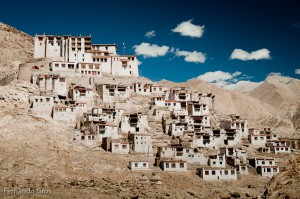Thiksey And Visual Aggression
Our visit to Thiksey Monastery brought one of the most extraordinary and perturbing experiences of the tour. While eating a quiet lunch, after a morning photographing, we were confronted by another traveller who took issue with our attempts to photograph, as a group, the monastery and its monks. In his words our whole approach was […]
Our visit to Thiksey Monastery brought one of the most extraordinary and perturbing experiences of the tour. While eating a quiet lunch, after a morning photographing, we were confronted by another traveller who took issue with our attempts to photograph, as a group, the monastery and its monks. In his words our whole approach was “…so aggressive.”
As is often the case, when people rant on behalf of others, our interlocutor came across as arrogant and condescending. Not just towards us – a group he did not know and seemed to have little interest in trying to understand – but, also towards those whom he probably imagined he was defending. In fact, he sounded like a spokesperson for post-colonial angst.
Which is a shame, because his broad point, about how our attempts to photograph places, either as individuals or in groups, affect those we try to shoot is an important one. Had our friend been a little more keen to converse and a little less keen to yell, it’s a topic I would have liked to discuss with him. Going forward, it’s a question I plan to bring up with every travel photographer I have the chance to meet.
For me, photographing in and around the places of worship was one of the most challenging aspects of the tour. I took a lot of photos of the rooftop call to prayer at Thiksey, but few for the rest of the day, or at the other gompas and monasteries that we visited. Even though I always felt the monasteries welcomed (and didn’t just tolerate) our presence, there is something about shooting people who are in prayer, or preparing to pray that makes me hesitant and cautious.
Permission and relationship play an important role here. I don’t photograph anyone who has made it clear they would not like to be photographed. Moreover, as a I learnt through the trip, the strongest images come when you have built some kind of connection with the people you are tying to make an image of; either by talking to them, spending time with them, or just waiting and observing them before you start to make images.
Such considerations aside, there is a troubling dynamic when you shoot as a group, be it three or thirty. The presence of a camera often changes the social fabric and multiple cameras can do so even more. Even amongst the nomads near Tso Moriri it was apparent that some, especially kids, were used to performing and posing for the camera.
I’m not sure what the answer is. On this tour we typically broke into smaller groups, often only two or three, when in more sensitive areas. But, even then you still have to be self-aware.
Truth is, even a lone photographer can cause insult and harm if their attitude is inappropriate. In a way, taking photos and making speeches are somewhat alike. Even when our ideas are good and noble, the way we approach the task, how we present ourselves and how we treat those we address will affect how we are received. In both cases poor execution can kill good ideas.





